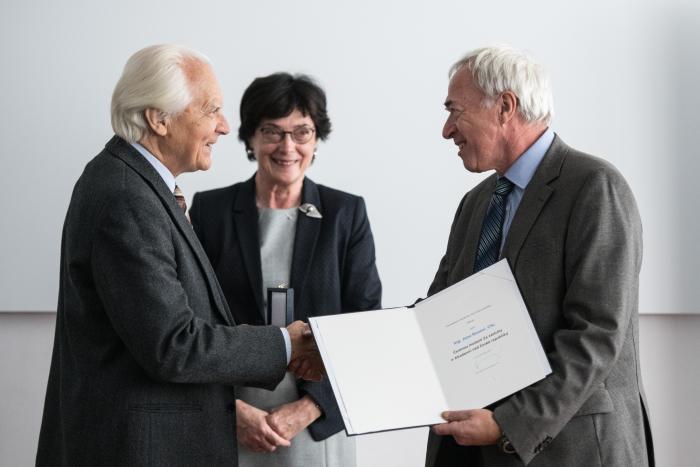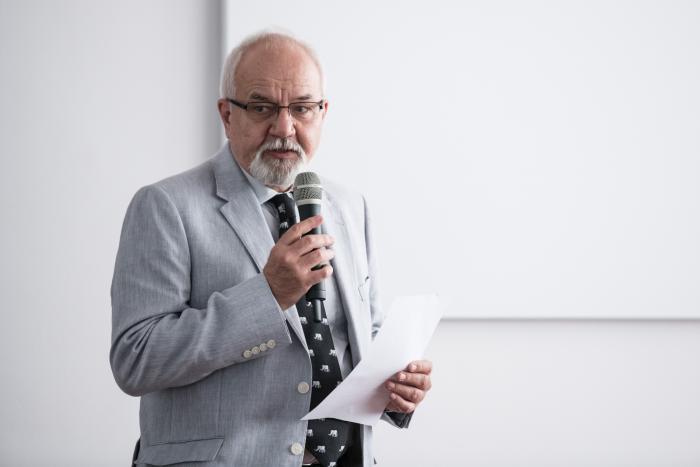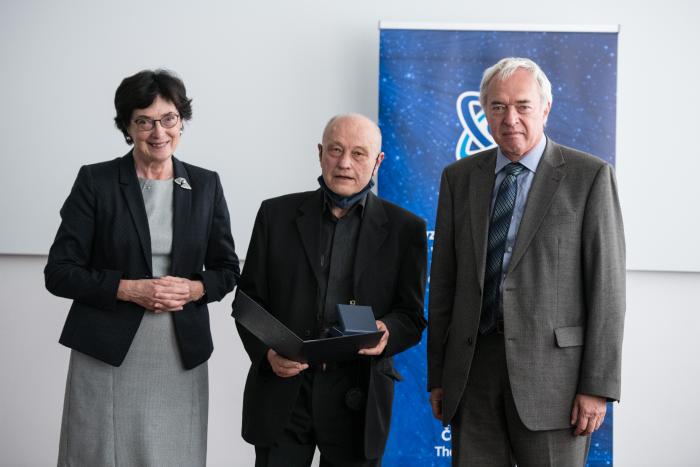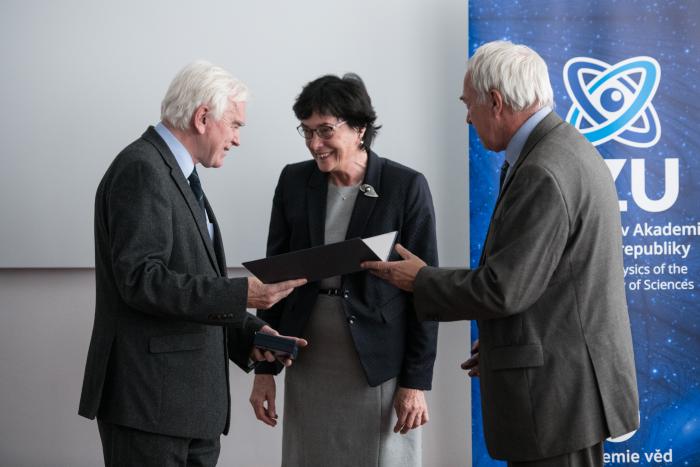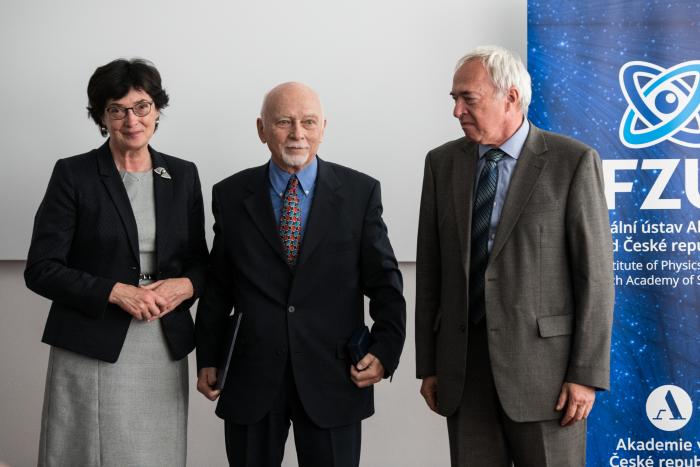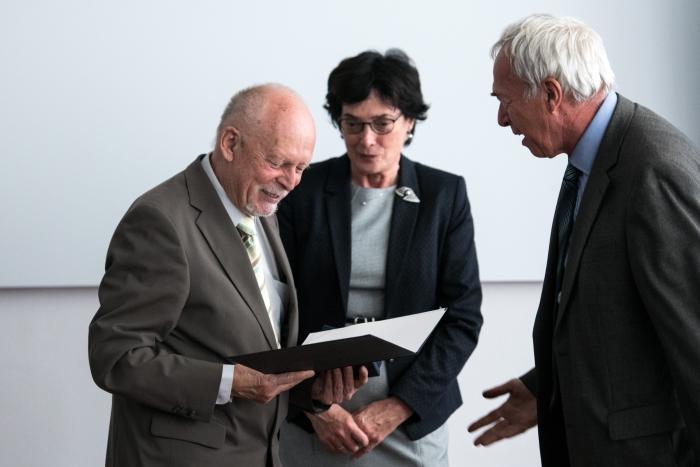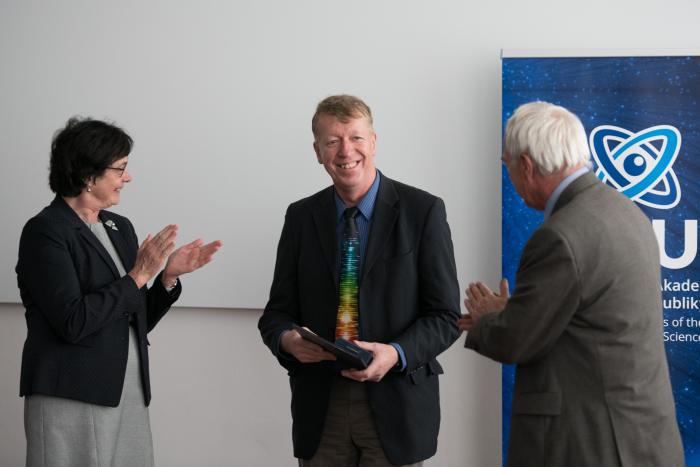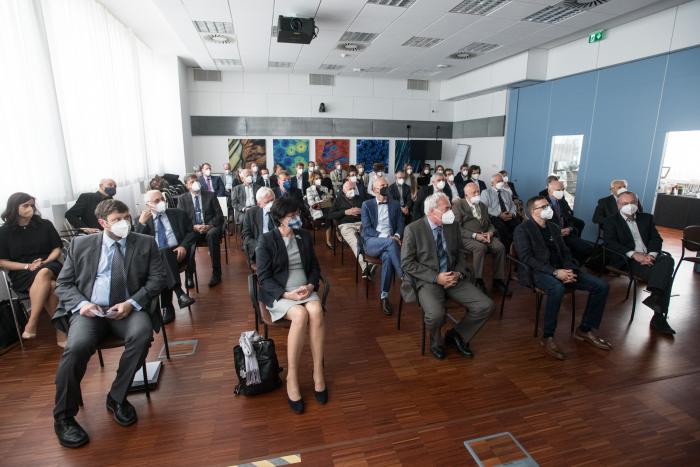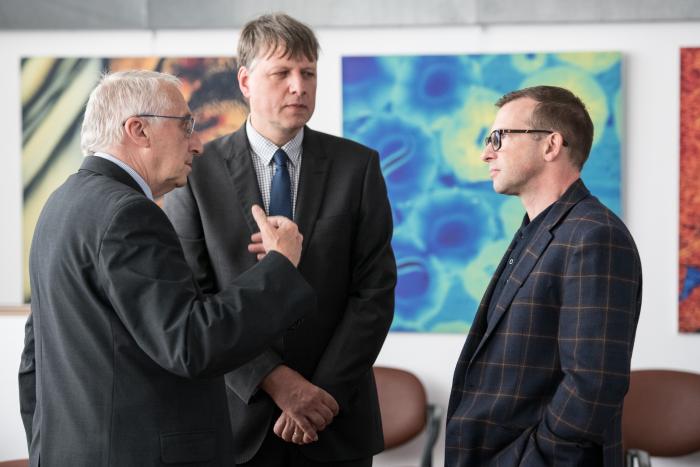At a ceremony on 22 September 2021, the president of the Czech Academy of Sciences Eva Zažímalová decorated five researchers from the Institute of Physics of the Czech Academy of Sciences for their achievements in physics. Two others from the FZU received medals for their Merit for the Czech Academy of Sciences for their excellent contribution to the development of their expert area.
In her speech, the Academy’s president highlighted their expertise and ability to lead and motivate other colleagues: “The Ernst Mach Award for achievements in physical sciences was awarded to five personalities of the world of science, and every one of them is a diamond. They came up with new visions, and they were all able to build well-functioning teams. This is what takes great skills and can’t be taken for granted,” she said.
The winners of this year’s Ernst Mach Medals for an outstanding contribution to the development of physical sciences are the following persons: (listed in alphabetical order) Miroslav Hrabovský from the Joint Laboratory of Optics of Palacky University Olomouc and the FZU, Jan Kočka from the Division of Solid State Physics (FZU), Pavel Lejček from the Division of Condensed Matter Physics (FZU), Pavel Novák from the Division of Solid State Physics (FZU) and Bedřich Rus who works at ELI Beamlines.
prof. RNDr. Miroslav Hrabovský, DrSc.
Miroslav Hrabovský is a leading Czech physicist in optics. For two decades, he led the Joint Laboratory of the FZU AV ČR and Palacky University, and significantly contributed to both facilities getting involved in great international collaborations in the area of particle physics and astrophysics at CERN, Pierre Augera Observatory, Cherenkov Telescope Array etc.
Miroslav Hrabovský focused primarily on wave and statistical optics, optical and laser technologies, and he played an important role in constructing unique instruments based on optics with application in experimental astrophysics, particle physics and industry. His contribution was particularly considerable in the development of contactless motion detection and deformation of the body methods for optical speckle interferometry.
RNDr. Jan Kočka, DrSc.
Since he joined the Institute of Physics, Jan Kočka’s study focused on heavily alloyed materials, specifically amorphous semiconductors – which, at that time, was a very promising research direction initiated by J. Tauc. Jan Kočka’s persistent and innovative approach to the experimental study of dielectric and transport properties of amorphous chalcogenide glass soon made him an acclaimed expert in the field.
At the outset of the millennium, Kočka turned his attention to a new class of promising microcrystalline silicon-based materials. His range of focus then involved, for example, the formation and the properties of superlattices with microcrystalline silicon, transport in fast growing microcrystalline layers and various aspects of the growth technology of such structures. Today he deals with catalytic growth of silicon nanowires and their application in the construction of next generation solar cells or in the preparation of silicon nanoparticles for photonics.
prof. Ing. Pavel Lejček, DrSc.
Pavel Lejček has earned international acclaim as expert in materials physics and metallurgy. In the long term, he’s been dealing with the relationship between the structure and the properties of grain boundaries in metallic materials.
Professor Lejček has shed new light on the admixture segregation at grain boundaries and on the relationship between the structure and the properties of grain boundaries. He has characterised the anisotropy of segregation, has recognized the importance of entropy in material research or described the relationship between the chemical composition of interfaces and their cohesion. His most significant achievements include the development of the method to predict chemical composition of individual grain boundaries facilitating applications in metallurgy.
Ing. Pavel Novák, CSc.,DSc.
Pavel Novák is one of the pioneers in electronic structure calculations in Czechia. His career was predominantly tied to the Wien2k programming pack developed by the Vienna-based research group led by K. Schwarz and P. Blaha. His most significant contributions to the aforementioned globally used tool include the introduction of spin-orbital interaction and the implementation of the so called LDA+U method, hybrid functionals and the exact-exchange, which are methods that are used extensively today in the study of topological insulators or in the description of ordered states of strongly correlated materials.
His life-long expertise has involved a detailed study of transition metal oxides and some important works by him deal with the charge ordering and the analysis of NMR experiments in magnetite as well as the study of electron structure of LaCoO3 and manganites.
Ing. Bedřich Rus, Ph.D.
With his relentless dedication to promoting international cooperation, Bedřich Rus significantly contributed to the preparation and the implementation of flagship research initiatives with pan-European outreach, such as ELI: Extreme Light Infrastructure, HiLASE or HiPER. By actively engaging in the ELI preparatory phase in 2007-2010, in which he was managing the consortium activities focusing on the development of new lasers, he paved the way for the Czech Republic’s successful nomination and its subsequent selection as the project’s location country. Dr. Rus also played an important role in establishing PALS research facility.
His key activity included a collaboration with the US based Lawrence
Livermore National Laboratory, in which he was successfully managing the development tasks of the Institute of Physics, and enabled an as-yet unprecedented transfer of cutting-edge laser technologies from the US to Europe.
Honorary medals for merits for the Czech Academy of Sciences were received by:
Ing. Jan Rosa, CSc.
Jan Rosa made a significant contribution to the establishment and the management of the Department of Optical Materials at the Institute of Physics in the 1990’s; he worked as Department’s manager and the deputy manager until 2008. In the 1990’s, he presided over the Research Council of the FZU for three election terms, and he also held a chair in the Supervisory Committee of the Institute of Physics.
Rosa made a significant contribution to the establishment, experiment design and the functioning of the Electron Paramagnetic Resonance Laboratory both at the Department of Optical Materials and the FZU’s SAFMAT infrastructure laboratory. He has authored and co-authored 107 publications (dtb. Scopus), his Hirsch index is H = 25.
Ing. Emil Šípek, CSc.
Emil Šípek is a long-term science and technology specialist at the Institute of Physics. Having joined the Institute of Physics in 1959, he was first involved in the maintenance of instruments but he gradually switched to the development and the design of electronic tools. Šípek has designed and built a number of unique instruments, whose parameters surpassed the then unavailable commercial devices, thus making a significant contribution to internationally acclaimed achievements of the Czechoslovak physics in the field of amorphous semiconductors. He was a respected member of the team for the development of a technology block for materials science under microgravitation conditions in the Interkosmos programme.
He pioneered the digitalization of measuring devices for scientific purposes, and he is a respected member of the Department of Thin Layers and Nanostructures and a co-author of publications.


